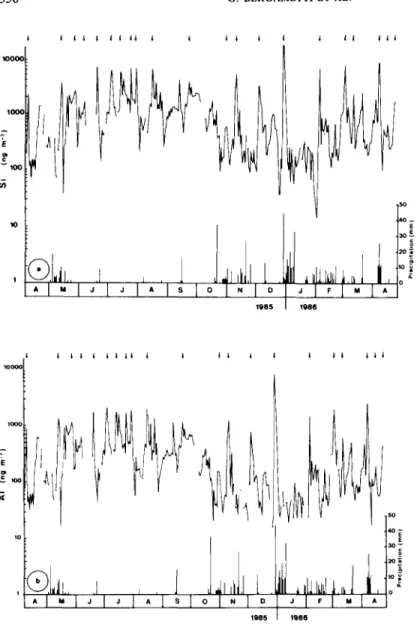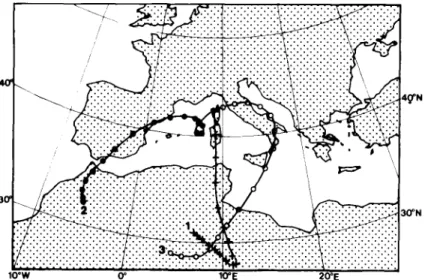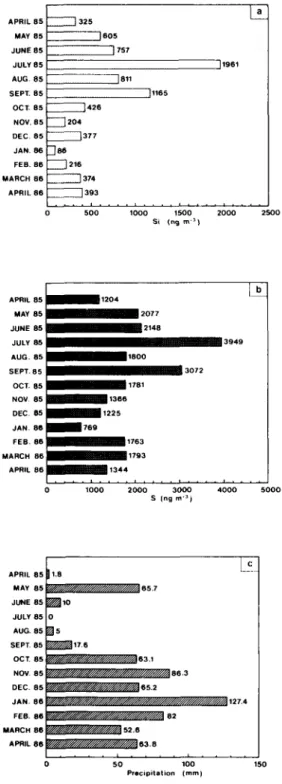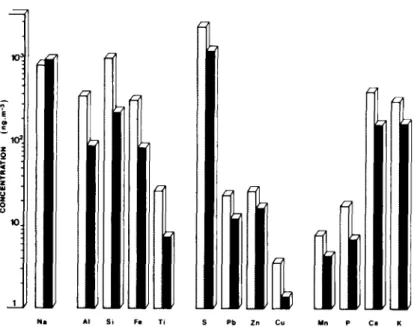HAL Id: hal-02328304
https://hal.archives-ouvertes.fr/hal-02328304
Submitted on 23 Oct 2019
HAL is a multi-disciplinary open access
archive for the deposit and dissemination of
sci-entific research documents, whether they are
pub-lished or not. The documents may come from
teaching and research institutions in France or
abroad, or from public or private research centers.
L’archive ouverte pluridisciplinaire HAL, est
destinée au dépôt et à la diffusion de documents
scientifiques de niveau recherche, publiés ou non,
émanant des établissements d’enseignement et de
recherche français ou étrangers, des laboratoires
publics ou privés.
Seasonal variability of the elemental composition of
atmospheric aerosol particles over the northwestern
Mediterranean
Gilles Bergametti, Alain-Louis Dutot, Patrick Buat-Menard, Rémi Losno,
Emmanouela Remoudaki
To cite this version:
Gilles Bergametti, Alain-Louis Dutot, Patrick Buat-Menard, Rémi Losno, Emmanouela Remoudaki.
Seasonal variability of the elemental composition of atmospheric aerosol particles over the northwestern
Mediterranean. Tellus B - Chemical and Physical Meteorology, Taylor & Francis, 1989. �hal-02328304�
Tellus (1989). 41B, 353-361
Seasonal variability of the elemental composition
of
atmospheric aerosol particles over the northwestern
Mediterranean
By GILLES BERGAMETTI*, ALAIN-LOUIS DUTOTY, PATRICK BUAT-MENARD$, REMI LOSNO* and EMMANOUELA REMOUDAKI*, *Laboratoire de Physico-Chimie de
I'Atmosphere, U A CNRS 71 7 , Universite Paris 7, 2 place Jussieu. F-75251 Paris Cedex 05, France; thboratoire de Physico-Chimie de I'Environnement, UA CNRS 71 7 , Universiti Paris 12, Avenue du GPnPral De Gaulle, F-94010 Criteil Cedex. France ; $Centre des Faibles Radioactivites, Laboratoire Mixte
CNRS-CEA. BP 1, F-91190 Gif-sur- Yvette, France
(Manuscript received 29 December 1987; in final form 20 July 1988)
ABSTRACT
Beginning in 1985, a continuous aerosol sampling program has been undertaken at a coastal location in northwestern Corsica. This site is 300 m above sea-level and at least 20 km from local pollution sources. I t is exposed during 80% or more of the time to maritime air masses which have travelled over the western Mediterranean from southern, western and northern directions. Daily 24-h aerosol samples were collected on 0.4 pm pore size nuclepore filters from a 10 m high tower and analysed for Al, Si, P, S, K , Ca, Ti, Mn, Fe and Zn by X-ray fluorescence, and for Na, Cu and Pb by flameless atomic absorption. The data obtained up to now, from April 1985 to April 1986, show that the temporal variability of the concentrations displays 2 distinctive patterns. First, a seasonal pattern is observed for the elements of continental origin, either natural (e.g.. Al, Si) or anthropogenic (e.g., S, Pb). This pattern is inversely related to the frequency and amount of rainfall such that the highest concentrations are observed between May and October. Estimates based on these data indicate an average time of 2 days to reload that atmospheric environment with aerosol particles from continental sources. This seasonal pattern is not observed for locally produced sea-salt aerosol particles (index Na), whose concentration is related to local wind speed. Elements associated with mineral aerosol particles exhibit sporadic but intense concentration peaks that are superimposed on this general pattern. 20 of these events were recorded for the sampling period considered with their frequency being maximal in spring and summer. 3-D air-mass trajectories show that all these events are associated with transport of soil dust from Africa.
1. Introduction
There is strong evidence that the atmospheric transport of trace-elements from anthropogenic and natural land-sources to the Mediterranean atmosphere plays a significant role in the geo- chemistry of Mediterranean sea-water (Arnold et al., 1982; GESAMP, 1985). The assessment of such a n influence requires a quantitative knowl- edge of atmospheric concentrations and fluxes over this marine environment. However, such a n assessment is difficult because of the strong vari-
Tellus 41B (1989). 3
ability of atmospheric elemental concentrations. Previous works (Arnold et al., 1982; Chester et al., 1984; Dulac et al., 1987) have shown that the atmospheric trace metals concentrations are highly variable on a daily time scale over the northwestern Mediterranean. This variability can be due to changes in continental source strengths, airflow and precipitation patterns. These pre- vious studies suggested that a continuous sam- pling strategy is needed to assess the inputs of trace-elements to the western Mediterranean marine environment o n a yearly time scale. Such
354 G . BERGAMETTI ET AL. a n approach has been conducted a t a coastal
site in Corsica Island since February 1985 (Bergametti, 1987). We present here daily atmos- pheric concentration data for some elements which are indicators of the major aerosol sources (soil erosion: Al, Si; pollution: S, Pb; sea-salt:
Na). The factors influencing the variability of their concentrations both a t the daily and seasonal time scale are discussed.
2.
Material and methods2.1. Sampling
Atmospheric samples were collected at Capo Cavallo (42"31'N, 8"40'E) on the northwestern coast of the Corsica Island. This site is located 300 m above sea-level and about 700 m distant from the shore line. It is exposed 80% of the time to marine air-mass coming to southwest to north- east. Moreover, the closest local pollution sources originating from the city of Calvi are distant from 20 km. The aerosol samples were collected a t the top of a 10 m-high meteorological tower. Bulk filtration samples were performed on 0.4 p m porosity nuclepore filters (diameter: 32 mm). Sampling duration was 24 h with a nominal airflow of 1 m3 h-I. Using these sampling procedures, collection efficiency was found to be similar to that obtained with high-volume Whatman 41 air filter samples. Blank filters were subjected to all the manipulations made on the filters, except air filtration.
2.2. Analytical methods
For all samples, the concentrations of Al, Si, P,
S, K , Ca, Ti, Mn, Fe, Zn have been determined
by wavelength dispersive X-ray fluorescence spectrometry (Compagnie Gtnerale de Radio- logie lo), according to the method described by Elichegaray et al., 1981. The sample is placed in an irradiation chamber and the excitation is produced by an X-ray tube with a C r (for Al, Si,
P, S, K , Ca, Ti) or W (for Mn, Fe, Zn) target. The intensity of the K, X-ray of each element is
counted at least twice during 50 to 70 s on a proportional gaseous flux detector (for Al, Si, P,
S, K , Ca, Ti, Mn, Fe) or a scintillation detector
(for Zn). Total countings were corrected for the contribution of blank filters. The absence of significant matrix effects was checked by using
three standards (Losno et al., 1987). The mean statistical errors taking into account the contri- bution of blank and uncertainties of the cali- bration curves are generally less than 10%.
Following X-ray fluorescence analysis, flame-
less atomic absorption spectroscopy was per-
formed to determine Na, Cu and Pb concen- trations. The sample is placed for about one week in a teflon bomb with 4 ml of HNO, Prolabo Normatom and 1 ml of HCIO4 Prolabo Norm- atom at a temperature of 60°C. The liquid residue (about 1 ml) is then adjusted to 5 ml with Milli-Q water. Working standards were prepared in a similar solution to allow matrix matching with the samples. The analyses were performed by using a Perkin-Elmer model 400 unit with H G A 500 graphite furnace. Mean relative errors have been estimated to 8% for Cu, 10% for lead and 12% for sodium.
2.3. Meteorological data and air-mass trajectories
Capo Cavallo is a station of the French meteorological network and all the basic meteorological parameters (wind velocity and direction, amounts of local precipitation,
. .
., etc.) were generally recorded with a 3- or 6-h step.Moreover, for each sample, 3-dimensional backward air-mass trajectories were computed to assess the transport of aerosol particles from their source regions by the Service des Etudes Speciales, Meteorologie Nationale, Paris. The air-mass trajectories were calculated over a period of 4 days, arriving a t the 925 and 700 hPa barometric levels, a t the mid-time of each sam- pling period. They have been computed from the analytical wind field of the European Center for Medium Range Weather Forecast of Reading, England (Lorenc et al., 1977). The calculation of the altitude of air transport is based on an approximation of the vertical component of the wind (Martin e t al., 1987).
3. Results and discussion
3.1. Daily cariations
The daily variations of concentrations between 6 April 1985 and 23 April 1986 for Si, Al, P b and
S are presented in Figs. la-d. Bulk data can be
found in Bergametti (1987). The geometric mean yearly concentrations of all the elements are
ATMOSPHERIC AEROSOL PARTICLES OVER THE NORTHWESTERN MEDITERRANEAN 355
Table 1. Yearly geometric mean and standard deci-
ation of’ elemental concentrations (ng m - j ) for the
whole sampling period (374 samples)
No.
significant Geometric Standard steps mean deviation Na 3 30 Al 360 Si 374 P 360 S 373 K 372 Ca 372 Ti 37 I Mn 314 Fe 312 cu 32 I Zn 293 Pb 329 1000 I68 427 1672 221 254 10.2 12.4 5.3 2. I 19.1 15.9 144 2.76 3.31 3.41 2.14 I .97 1.90 2.28 3.25 2.11 3.00 2.71 2.16 2.34
given in Table 1. The large standard deviations of the geometric mean suggest a significant vari- ability of atmospheric concentrations. As shown by Figs. la-d, a high variability of atmospheric concentrations is observed on time scales of the order of one day: for example, the Si and Al concentrations change by a factor 200 in less than 48 hours, between 28 and 30 December 1985.
Such strong variations for these two elements appear episodically through along the sampling period : high concentration episodes are more frequently oberved during summer and spring, more occasionally in fall and winter. On the other hand, low concentration episodes are frequently observed during fall and winter, more occasion- ally during summer. The air-mass trajectories (Fig. 2) indicate that all these high dust events were associated with transports from the arid or semi-arid African regions and corresponded to Saharan dusts inputs (Bergametti, 1987). 20 Saharan dusts events were observed during the sampling period (about 1 year).
Such high concentration levels d o not appear on the figures Ic and Id which illustrate the daily variation of lead and sulfur. These elements result principally in the Mediterranean atmosphere of
anthropogenic emissions by opposite to Al and Si which are predominantly of crustal origin (Buat- Mtnard, 1986).
On the opposite, low concentration values are observed the same days for these four elements. Taking into account the different source-types and source-regions of these elements in the Mediterranean atmosphere, respectively the soil erosion and the human activities, this similar behaviour may not result only from changes in air-flow patterns. Precipitation data (Figs. la-d) indicate that the lowest concentration episodes correspond to sampling periods when the atmosphere was locally washed by rain. It can therefore be suggested that precipitation scaveng- ing can explain the considerable decrease in con- centrations which we observe simultaneously for
Al, Si, S and Pb. For example, the largest de-
crease in Si and Al concentrations (by a factor of 200) observed from 28-30 December 1985 corre- sponds to a Saharan dust event followed by local precipitations. For this period, air-mass trajec- tories indicate no change in airflow pattern.
3.2. Seasonal pattern
The data presented in Figs. la-d suggested also that these intense, short-term variations of atmos- pheric concentrations are superimposed on a seasonal pattern. Such a pattern is more clearly evident in Figs. 3a, b where are reported the monthly geometric mean of atmospheric concen- trations. 2 well-defined periods during the year can be distinguished : (a) the Mediterranean “summer” (May-October) during which geo- metric mean concentrations of Si and S are
respectively 1100 ng m-3 and 2660 ng m-3; (b) the rest of the year, between October and April,
is characterized by lower mean concentrations (Si: 237 ng m-3 and S : 1360 ng m-3).
Two factors can explain these different seasonal changes in atmospheric concentrations :
( I ) a seasonal change in continental source strengths and/or airflow patterns and/or (2) a different removal rate for atmospheric particles between these two periods.
The first factor can be ruled out for the following reasons : a 10-year climatological study
of airflows (1975-1984) in the northwestern Mediterranean region by Miller et al. (1987) indicates little or no seasonal variations of the frequency of airflow patterns at the 850 hPa barometric level. We checked that this was also the case for the sampling period considered here.
356 G. BERGAMETTI ET AL.
1 I I I I I 1 I 4 4 I I 1 I I 1 I I 1 1 1
1985 I 1986
I I 4 1 I I I I I 1 I I 1 I I 1 I I I 1 4
1985 I 1986
Fig. 1. Daily atmospheric concentrations (in nanograms per cubic meter) at Capo Cavallo (western Mediterranean Sea); (a) Si; (b) Al; (c) Pb; (d) S. The arrows indicate southern airflows identified by air mass trajectories. The daily amount of precipitation is reported at the bottom of the figure.
Moreover, the similar behaviour oberved for elements emitted by different land-based sources suggests that the temporal variations of the source strengths are probably a factor of minor importance.
These observed seasonal changes seem to be better related to the local precipitation rate :
indeed, the low concentration season corresponds to the rainy period in the western Mediterranean
while the high concentration period occurs during the dry season (Fig. 3c).
Although our data set concerns only a one-year period, these observations strongly suggest the existence of a seasonal cycle of the atmospheric aerosol concentrations in the Mediterranean region : indeed, the precipitation patterns, which seem to be the major factor responsible for seasonal changes in aerosols concentrations,
ATMOSPHERIC AEROSOL PARTICLES OVER THE NORTHWESTERN MEDITERRANEAN 357
L
I t t t l i l t I I 1 1 1 4 I I I I t 1
t - I
Fig. I (continued)
are characterized themselves by a well-known seasonal cycle in the western Mediterranean.
Fig. 4 illustrates that this seasonal cycle is observed for all the elements derived from land- based sources: crustal origin (Al, Si, Ti, Fe), anthropogenic origin (S, Cu, Zn, Pb) and mixed origin (Mn, P, Ca, K) (Bergametti, 1987). This seasonality does not appear to be controlled by the size of aerosol particles since these elements
are present in different particle size classes-fine fraction for sulfur and lead, coarse fraction for aluminium and silicon (Dulac et al., 1987; Bergametti, 1987).
In contrast, N a exhibits a different behaviour, with no difference of the mean geometric concen- trations between the two periods.
Since N a is primarily associated with large sea- salt particles, its source is likely to be mostly
358 G . BERGAMETTI ET AL.
Fig. 2. Examples of backward air-mass trajectories coming from north Africa and ending at the 700 hPa barometric level. These air-mass trajectories arrives on: ( 1 ) 1 March 1986; (2) 16 July 1985; (3) 22 September 1985.
local. This local character can be clearly shown for our data set. Indeed, Fig. 5 shows the classical relation between Na concentrations and local wind speed as previously observed by Lovett (1978).
The presence of a marine source, very close to our sampling site, is therefore likely responsible for a very fast reloading of the atmosphere with sea-salt particles following a rain event. These considerations give further evidence that the sources of the other elements are not local. Their concentrations are related to a long-range trans- port of particulate matter from continental sources. Dulac et al. (1987), by using air-mass trajectories, reached the same conclusion.
3.3. Apparent turn ocer time of’ aerosol particles
The elements subject to a long-range transport from continental source-regions exhibit lower concentrations during the rainy period (Fig. 4). This applies to both pollutant elements and to those associated to mineral aerosol particles derived from soil erosion. Since air-flow patterns d o not exhibit seasonal variations (see above), mean seasonal concentration changes can be due to seasonal changes in source strengths and/or to the effect of precipitation scavenging. The first factor is probably not dominant since it is un-
from land-based sources
likely that elements of different origins would exhibit temporal changes in source strengths of the same magnitude (Fig. 4). Precipitation scavenging appears therefore to be the major cause of the observed pattern.
Moreover, on a shorter time scale, air-mass trajectories a t various barometric levels indicate that sharp decreases in concentration observed during a period of precipitation can occur without changes in air-flow patterns (Bergametti, 1987). It seems, therefore, that during the low concentration period (fall and winter), the Mediterranean atmosphere is not completely reloaded between two rain events. Thus, it might be concluded as a first approximation that the mean time interval between two rain events during the rainy season is shorter than the mean travel time of continental aerosols from source- regions to Corsica. This travel time can be esti- mated by dividing the duration of the rainy season by the number of days with precipitation. This gives a minimum travel time of about 2
days. The validity of such an estimate has been checked using two other approaches. First, in the case of a n interval greater than two days between two consecutive rain events, it is possible to determine the time necessary for the concen- trations of any element to reach its pre-rain level. Such cases are observed o n the Figs. l a 4 and Tellus 41B (1989), 3
ATMOSPHERIC AEROSOL PARTICLES OVER THE NORTHWESTERN MEDITERRANEAN 359 APRIL 85 MAY 85 JUNE 85 AUG 8 5 , JULY 85 SEPT 85 OCT 85 NOV 85 OEC 85 JAN 86 FEB 88 MARCH 86 APRIL 86
r
325 I805 1 757 J 811 11961 11165 I426 3 2 0 4 377 1 8 6 3 2 1 61
374 -2
393 I 0 500 1000 1500 2000 2500 APRIL 85 MAY 85 JUNE 85 JULY 85 AUG 85 SEPT 85 OCT 85 NOV 85 DEC 85 JAN 86 FEE 88 MARCH 86 APRIL 86 0 1000 2000 3000 4000 5000 S lng m ’ I 85.71
c
OCT 85 NOV 85 DEC 85 JAN 6 6 FEB 86 MARCH 86 APRIL 86 0 50 1 0 0 150 Precipitation ( m m )Fig. 3. Monthly geometric means of atmospheric con- centrations of (a) Si; (b)
s,
and monthly mean rainfall(C).
indicate that this “reloading” time is generally of the order of 2-3 days.
Second, taking into account the observed airflow patterns during the rainy season, a travel time of about two days corresponds to a travel distance of about 1000 km. This is approximately the distance between Corsica Island and Spanish
or African coasts from which more than 70% of the sampled air-masses originate (Bergametti,
1987).
4. Conclusion
This work was focused on the temporal vari- ability of the atmospheric concentrations in the western Mediterranean Sea. A continuous sam- pling of particulate matter has been performed over a one year period on a Corsican coastal site. The strong daily variations of concentrations are mainly due to the Saharan dusts inputs (for the crustal elements) and to the removal of aerosols by precipitation events. Moreover, the precipitations are responsible for the existence of a seasonal cycle for the atmospheric concen- trations : during the dry season, the atmospheric concentrations are 2-3 times higher than during the rainy season. Na, which is used as a tracer of sea-salt particles, does not exhibit such a behav- iour. This specific behaviour is explained in relation with the local character of the marine source. This allows to conclude that the presence of other elements (of crustal, anthropogenic or
mixed origin) results from a long-range transport from continental source-region. A mean travel time of about two days seems to be a good
estimate of the duration of the long-range trans- port between continental source-regions, primar-
ily Spain and north-Africa, and the Corsican atmosphere.
5.
AcknowledgementsWe wish to thank the staff of the signal station of Capo Cavallo for their logitical support during the field experiments in Corsica. We also thank the French Marine Nationale for the free access to the signal station and the French Direction de la Meteorologie Nationale for the use of the meteorological tower a t Capo Cavallo. We are Tellus 418 (1989), 3
360 Y 8 7
:i/
G . BERGAMETTI ET AL. N. A1 S I Fe TI S Pb ZnIL
Cu M” P c.I
Fig. 4 . Geometric means of atmospheric concentrations during the dry and the rainy seasons at Capo Cavallo.
3.25 3.00 log Na = 0 . O 4 2 V v t r 0 . 9 1 2 . 8 2 2.50L 1 1 I I I 0 2 4 6 8 10 WIND SPEED ( m s-’1
Fig. 5 . Atmospheric sodium concentrations versus local wind-speed.
grateful to B. Chatenet, L. Gomes, F. Dulac This work was supported by the Centre and U. Ezat for their assistance in sampling National de la Recherche Scientifique (ATP and analysis. We are particularly grateful to ACrosols DCsertiques, PIREN-TOAE) and the D. Martin, B. Straws and J. M. Gros who have Ministere de I’Environnement (Action Pollution computed the air-mass trajectories. de Fond-Echanges dans I’atmosphere).
ATMOSPHERIC AEROSOL PARTICLES OVER THE NORTHWESTERN MEDITERRANEAN 36 1
REFERENCES Arnold, M., Seghaier, A., Martin, D., Buat-Menard, P.
and Chesselet, R. 1982. Geochemistry of the marine aerosol over the western Mediterranean Sea. In: Comptes Rendus des V I journees d’itudes sur les pollutions marines en Miditerranbe. CIESM Monaco, 27-37 (in French).
Bergametti, G. 1987. Atmospheric inputs to the western Mediterranean Sea: geochemical and meteorological aspects. Ph.D. Thesis. Universite Paris 7, 302 pp (in French).
Buat-Menard, P. 1986. The ocean as a sink for atmos- pheric particles. In: The r6le of air-sea exchange in geochemical cycling (ed. P. Buat-Menard). Dordrecht/ Holland: D. Reidel Publ. Comp., 165-181.
Chester, R. Sharples, E. J., Sanders, G. S. and Saydam, A. C. 1984. Saharan dust incursion over the Tyrrhenian Sea. Atmos. Environ. 18, 929-935. Dulac, F., Buat-Menard, P., Arnold, M. and Ezat, U.
1987. Atmospheric input of trace metals to the western Mediterranean Sea: 1. Factors controlling the variability of atmospheric concentrations. J . Geophys. Res. 92, 8437-8453.
Elichegaray, C., Vie le Sage, R., Grubis, B. and Colin, J. L. 1981. Analysis of atmospheric aerosols by X-ray fluorescence: determination of correcting factors. Analusis 9, 492497 (in French).
GESAMP (Joint Group of Experts on Scientific Aspects of Marine Pollution) 1985. Atmospheric transport of contaminants into the Mediterranean region. Reports and Studies GESAMP 26. World Meteorological Organisation, 53 pp.
Lorenc, A,, Rutherford, I. and Larsen, G. 1977. The ECMWF analysis and data assimilation scale analy- sis of mass and wind field. ECMWF Tech. Rep. 6 , Eur. Cent. for Medium-Range Weather Forecasts, Reading, England.
Losno, R., Bergametti, G. and Mouvier, G. 1987. Determination of optima conditions for atmospheric aerosols analyses by X-ray fluorescence. Environ. Tech. Letters 8, 77-87.
Lovett, R. F. 1978. Quantitative measurements of air- borne sea-salt in the north Atlantic. Tellus 30, 358- 363.
Martin, D., Mithieux, C. and Strauss, B. 1987. On the use of the synoptic vertical wind component in a transport trajectory model. Atmos. Environ. 21,45-52. Miller, J. M., Martin, D. and Strauss, B. 1987. A
comparison of results from two trajectory models used to produce flow climatology to the western Mediterranean. NOAA Tech. Memorandum ERL ARL-151, NOAA, Air Resources Laboratory, Silver Spring, Maryland, USA.



